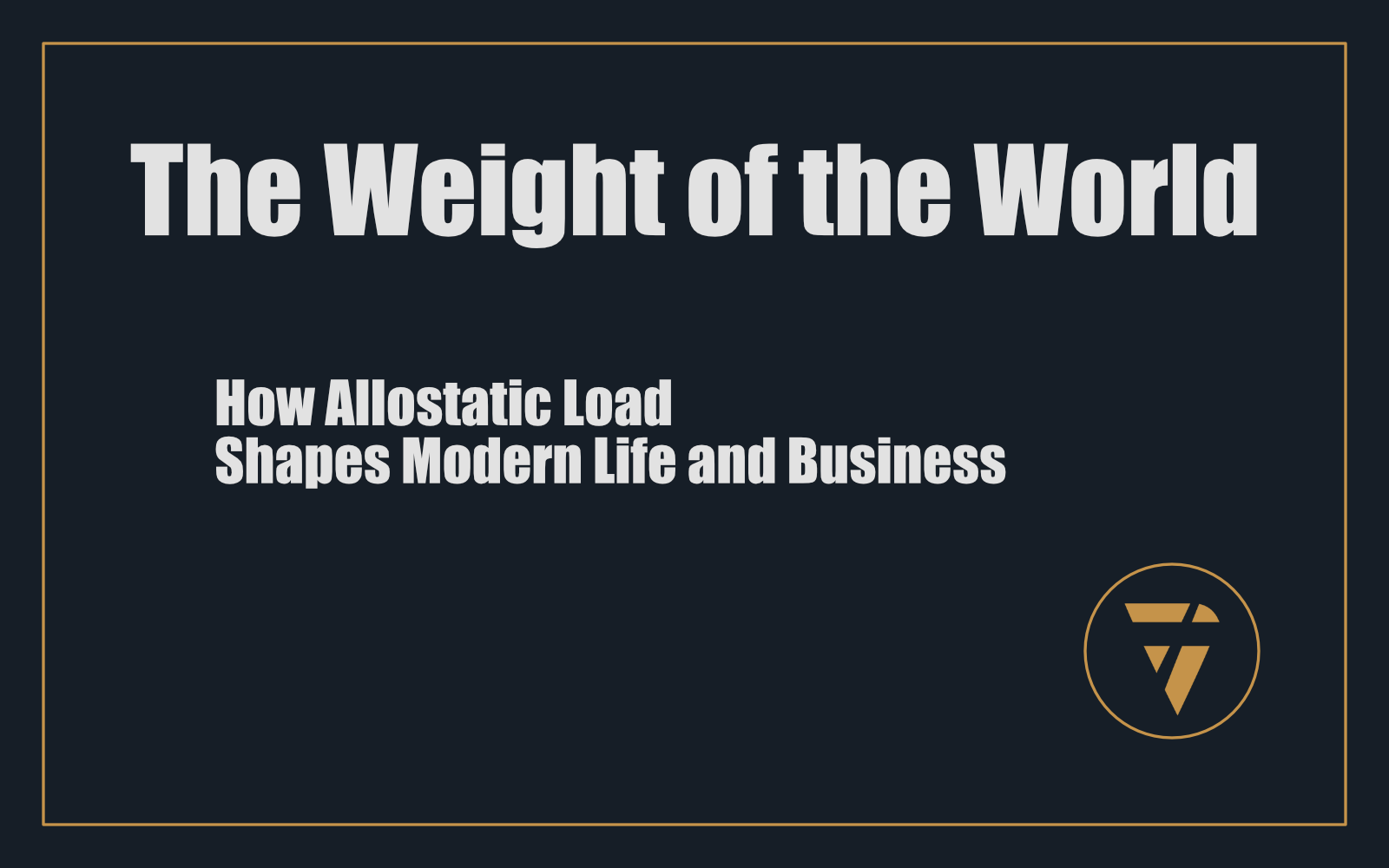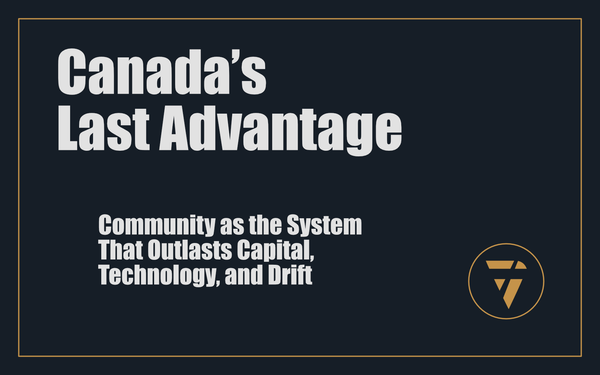The Weight of the World

How Allostatic Load Shapes Modern Life and Business
Imagine carrying an invisible weight, one that grows heavier with each passing day. It’s not physical, yet it affects the body as profoundly as any tangible burden. This is allostatic load, the cumulative toll that chronic stress places on our physiology, cognition, and decision-making. In an era defined by rapid technological change, economic uncertainty, and relentless professional demands, allostatic load has emerged as one of the most pressing, yet overlooked, challenges to personal health, leadership effectiveness, and business resilience.
The human body, a marvel of adaptation, was designed to endure acute stressors, brief moments of intense demand followed by recovery. But in the modern world, stressors are no longer fleeting; they're constant. Notifications, economic instability, leadership pressures, social media toxicity, and 24/7 connectivity ensure that our stress-response systems remain engaged far longer than nature ever intended. The result? A slow, insidious breakdown of the body’s ability to cope, leading to chronic illness, cognitive decline, and impaired performance at every level.
Understanding Allostatic Load: A Biological Perspective
At its core, allostasis refers to the body's ability to maintain stability through change. Unlike homeostasis, which seeks to keep internal conditions stable, allostasis allows the body to anticipate and respond to stressors dynamically. The problem arises when the system is overused, when the "wear and tear" from prolonged exposure to stressors accumulates, disrupting core biological functions.
Key physiological systems affected by allostatic load include:
- The Hypothalamic-Pituitary-Adrenal (HPA) Axis: Chronic stress dysregulates cortisol, leading to metabolic disorders, weakened immunity, and cognitive dysfunction.
- Autonomic Nervous System (ANS): An overactive fight-or-flight response contributes to hypertension, cardiovascular disease, and disrupted digestion.
- Immune Function: Chronic stress suppresses immune responses, making individuals more vulnerable to infections and inflammation-based diseases.
- Neural Plasticity & Cognitive Function: Excessive stress impairs memory, decision-making, and emotional regulation—critical functions for executives, entrepreneurs, and professionals.
The Business of Stress: Allostatic Load in Leadership and Entrepreneurship
If allostatic load is the silent force eroding personal well-being, it is equally destructive in the business world. Leaders operate under immense pressure, driving performance, navigating uncertainty, making high-stakes decisions, and managing teams. Over time, accumulated stress impairs their ability to think strategically, innovate, and lead effectively.
1. Cognitive Deterioration and Decision Fatigue
Chronic stress depletes executive function, the very capacity leaders rely on to prioritize, analyze, and execute strategy. A high allostatic load erodes working memory, increases impulsivity, and reduces problem-solving ability, often resulting in poor business decisions, choosing short-term survival over long-term sustainability, reacting emotionally rather than strategically, or failing to innovate in the face of disruption.
2. Emotional Exhaustion and Burnout
In an era that glorifies the "grind," burnout has become an epidemic. Leaders operating under excessive allostatic load develop emotional exhaustion, losing the passion and resilience needed to drive organizations forward. They become reactive instead of proactive, unable to inspire, adapt, or handle interpersonal dynamics effectively.
3. The Ripple Effect on Organizational Health
An overstressed leader creates a stressed organization. Employees mirror leadership energy, when leaders exhibit chronic stress symptoms (fatigue, irritability, decision paralysis), the organizational culture absorbs it. This leads to lower engagement, higher turnover, and diminished productivity. Companies with leaders suffering from high allostatic load often experience:
- Increased absenteeism
- Higher healthcare costs
- Toxic work environments
- Reduced innovation and adaptability
The Modern Workplace: An Engine of Chronic Stress
Today's corporate environment exacerbates allostatic load. Consider the following modern stress multipliers:
- Always-On Culture: Work follows employees home via smartphones, erasing boundaries between professional and personal life.
- Hyper-competition: The pressure to "scale at all costs" creates a relentless demand for performance, often at the expense of employee well-being.
- Uncertainty & Economic Instability: Layoffs, market volatility, and job insecurity create chronic financial stress.
- Information Overload: The constant influx of data, notifications, and digital distractions overloads cognitive capacity, reducing efficiency.
Breaking the Cycle: Reducing Allostatic Load in Leadership and Business
While allostatic load is cumulative, it is not irreversible. Businesses and individuals can mitigate its effects and create resilience through strategic interventions.
1. Strategic Mindfulness and Recovery
Mindfulness is not just a personal wellness tool, it’s a strategic necessity. Leaders who incorporate structured mindfulness practices into their workflow experience improved cognitive clarity, emotional regulation, and decision-making.
Practical Implementation:
- Mindful Leadership Training: Integrate mindfulness into executive coaching programs.
- Scheduled Recovery Time: Encourage leaders to take cognitive breaks (nature walks, meditation, silent reflection) to reset stress response systems.
- Intentional Task Switching: Reduce cognitive overload by structuring work to allow for deep focus and undistracted decision-making.
2. The Science of Sleep and Neurological Recovery
Sleep is the most potent tool for reducing allostatic load. Yet, many executives operate on chronic sleep deprivation, worsening stress-related decline.
Actionable Changes:
- Enforce device-free evenings to support circadian rhythms.
- Schedule decision-heavy meetings in the morning when cognitive resources are highest.
- Implement corporate sleep hygiene programs (adjusted work hours, flexible rest policies).
3. Rebuilding Resilient Organizations
Reducing allostatic load isn’t just a leadership concern, it’s an organizational imperative. Businesses should integrate stress-reduction principles into corporate culture.
Organizational Strategies:
- Flexible Work Models: Reduce burnout by allowing employees to work in rhythms aligned with their natural productivity cycles.
- Stress-Resilient Workflows: Implement structured deep work periods without interruptions.
- Leadership Resilience Training: Teach executives how to identify and reduce their own allostatic load before it affects company performance.
4. The Economic Case for Stress Reduction
Reducing allostatic load isn’t just good for people—it’s good for profits. Companies that prioritize employee resilience experience:
- Lower healthcare costs (fewer stress-related diseases).
- Higher retention and engagement (reducing turnover expenses).
- Improved decision-making and innovation (leaders make better strategic moves).
The Future of Leadership in an Age of Chronic Stress
The modern world demands adaptability, resilience, and sustained high performance. But leaders and organizations will only thrive if they rethink their relationship with stress. Allostatic load is an invisible tax on personal well-being and business success, one that, if left unchecked, leads to cognitive decline, poor decision-making, and organizational instability.
The solution lies not in working harder but in working smarter, leveraging strategic mindfulness, structured recovery, and resilient business models. The best leaders of the future won’t be those who endure stress the longest; they’ll be the ones who understand how to manage, mitigate, and optimize their response to it.
If business is an endurance race, then reducing allostatic load is the key to staying in the game. The question isn’t whether stress exists, it does. The question is whether we will adapt intelligently, or collapse under its weight.
Which future will you choose?
This is what I’m working on. Tell me what you think, I enjoy the conversation! Subscribe and follow the work in real time.
Thanks!
B

You’re not burned out. You’re overloaded.
Chronic stress isn’t just mental, it rewires your body, clouds decisions, and kills innovation. The best leaders don’t push harder; they adapt smarter.
If your success depends on your endurance, how much longer can you sustain the weight?
PS -






